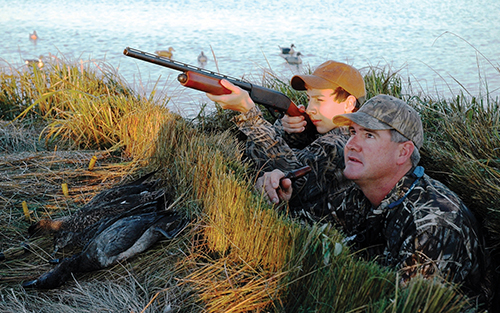Teaching children about the outdoors creates bonding experience
By John N. Felsher
Thousands of sportsmen, young and old, will take to the forests, fields and wetlands across Alabama this fall to participate in various outdoors activities.
According to a recent survey by HunterSurvey.com, nearly 46 percent of sportsmen took at least one child hunting in the previous year. Most people probably start hunting because their father, uncle or grandfather liked hunting and wanted to share his favorite sport. Increasing numbers of young women take up hunting each year, often to spend more time with their husbands or boyfriends. The number of women hunting for their first time increased 25 percent between 2005 and 2011.

Photo by John N. Felsher
I grew up fishing and hunting with my dad. He loved teaching young sportsmen about the outdoors and would rather watch a child catch a fish than land a state record himself. Dad always used to say, “You can either fish or take small children fishing, but you can’t do both at the same time. Decide what you are going to do and stick with it.”
The same philosophy applies to hunting. When hunting with young children, Dad frequently carried his gun, but rarely fired it. He preferred to watch children, or even young adults who had never hunted before, do the shooting and would rather miss a chance to make a shot himself than take an opportunity away from a child.
Too many sportsmen don’t understand this philosophy. They want to hunt more than they want to take their children hunting. Some sportsmen think young children should already possess the skills of Daniel Boone and yell at the youngsters when they make mistakes. Instead of yelling, teach children how to do something correctly. Don’t do everything for a child, but let young sportsmen learn by doing and even making mistakes. Just make sure they don’t do anything that could harm themselves or anyone else.
Make any outing interesting and enjoyable for young children. Instead of taking young children deer or turkey hunting, where they must sit quietly and motionless for long periods, take them on a more active excursion, such as following beagles on a rabbit hunt. Even during the offseason, people can walk through a park or preserve and “hunt” without actually firing a shot. See how many squirrels a child can spot. Let a child practice stalking skills and see how close he or she can get to a squirrel or rabbit without spooking the animal. This teaches young sportsmen woodsmanship skills.
Knowing the value of spending time with his children, Dad always tried to turn our outings into adventures. Even before I could carry a BB gun, he explained the interconnected web of nature. While walking in the woods, he took time to point out tracks and animal signs. He taught us to identify various birds and animals we spotted even if that meant taking home one less game animal in the bag.
Never compromise on safety
Although Dad didn’t care as much about bagging a limit as enjoying a good time, he never compromised on safety. From an early age, he pounded gun safety into our heads. Whenever we wanted to look at his guns, he let us do so with his supervision. We never handled a gun without first checking to make sure it was unloaded. We never pointed a gun at anything we didn’t want to shoot and never shot at anything until we absolutely identified the target and what lay beyond it so we could make a safe shot. If that meant not taking a shot and letting a game animal escape, that’s what happened. Whenever a new person, old or young, came along for a hunt, Dad always gave that person a crash course in gun safety and made his rules perfectly clear before anyone loaded a firearm.
To make an interesting adventure for a young sportsman, try hunting from a small boat. Federal laws prohibit shooting at migratory birds from boats under power or sail, but people can hunt from paddle-powered craft. The adult can paddle from the stern and point out game while the child remains ready to shoot while comfortable in the bow. When hunting from a boat, sportsmen can carry refreshments and take occasional breaks. In many parts of Alabama, sportsmen can successfully hunt squirrels, rails, gallinules, coots and ducks from small boats.
A shooting preserve makes another great place to introduce children to hunting. Shooting preserves release pen-raised birds, such as quail, chukar or pheasant. Guides work trained dogs to find, flush and retrieve birds. This type of hunt guarantees action and helps a youngster improve his or her wing shooting skills. Sportsmen can find shooting preserves throughout the state at www.alabamaquailtrail.com.
Because hunting with a child takes effort, sacrifice and patience, many sportsmen prefer the company of like-minded adults. That’s fine, but a parent will never meet a better fishing or hunting partner than one created over time – the most precious and fragile of all gifts.
[hr]
John N. Felsher is a professional freelance writer and photographer who lives in Semmes, Ala. He’s written more than 1,700 articles for more than 117 magazines. He co-hosts a weekly outdoors radio show. Contact him through his website at www.JohnNFelsher.com.






